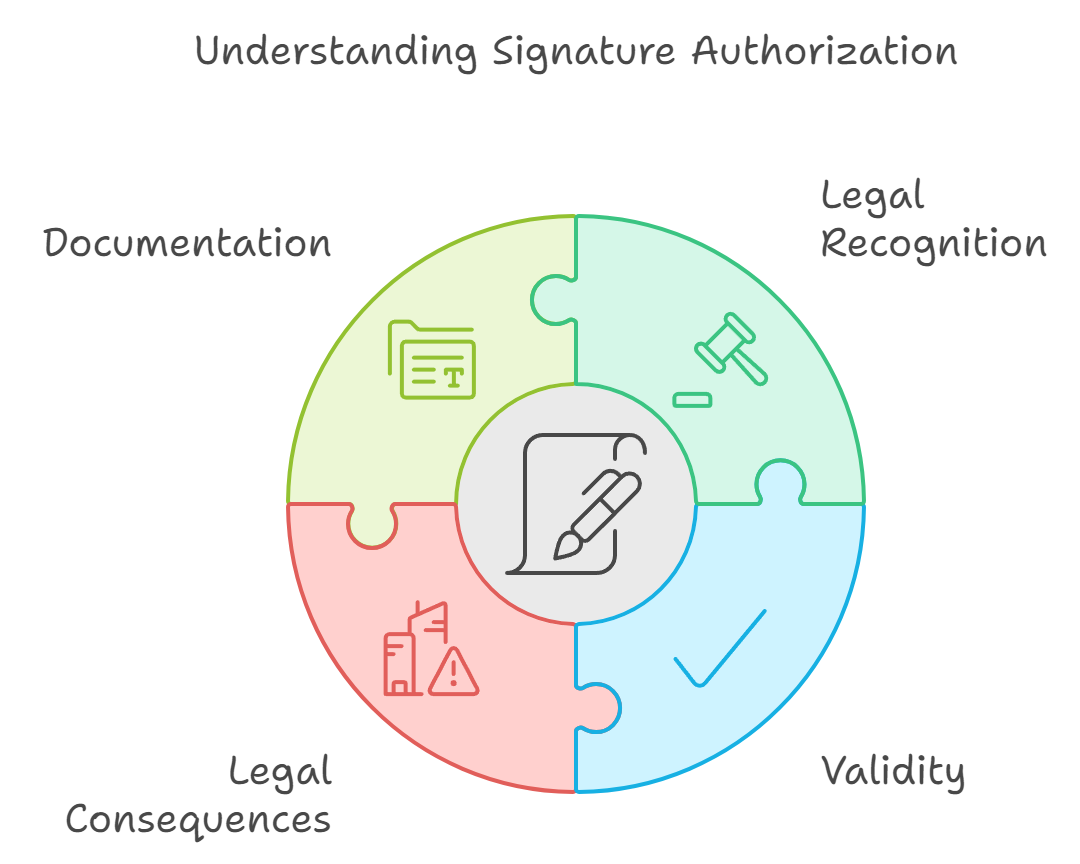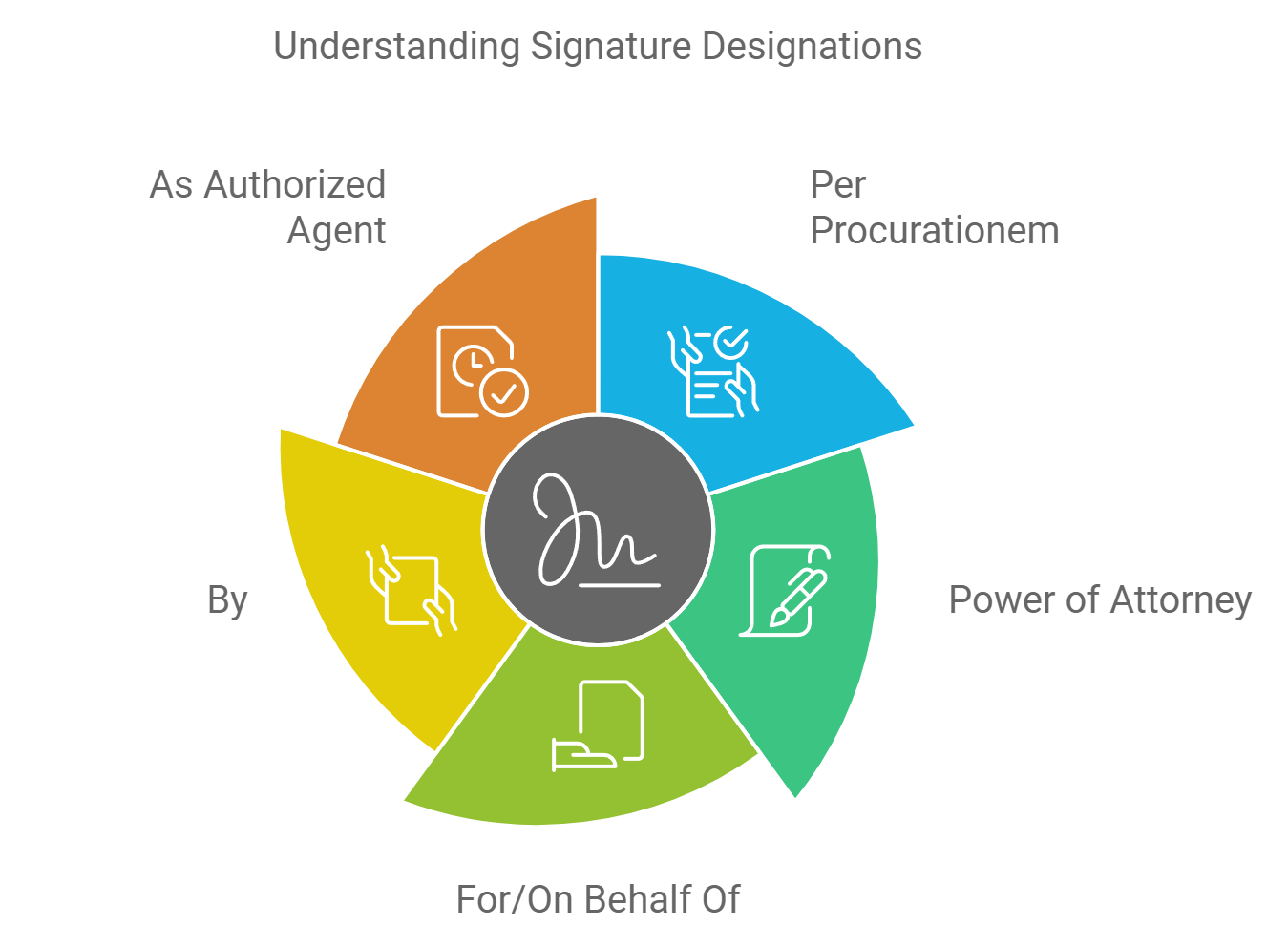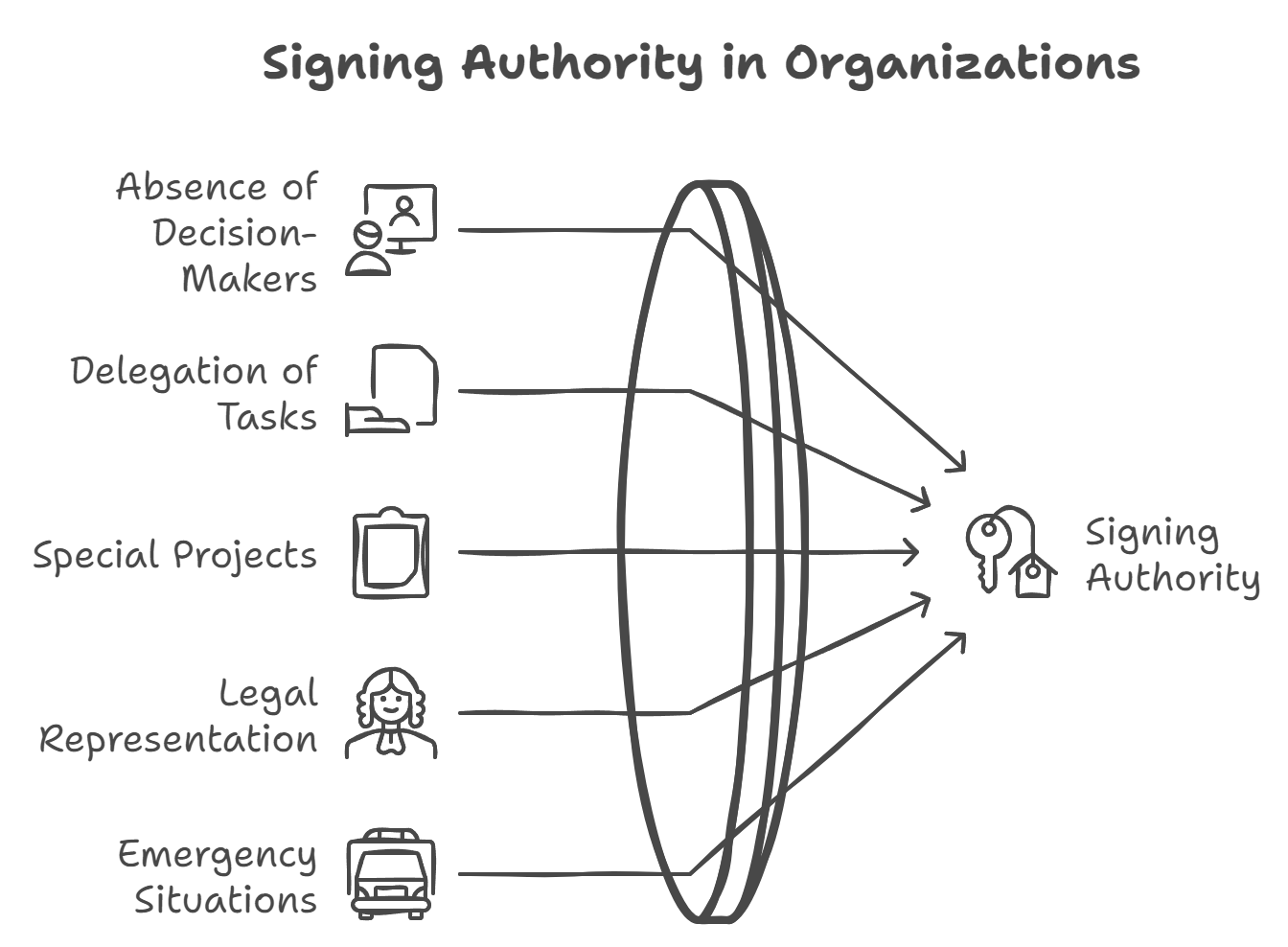How to sign on Behalf of Others: p.p., for/on behalf of, etc.
Correctly using abbreviations like p.p., for/on behalf of, and as authorized agent while signing on someone else’s behalf is crucial. It’s not just about formal correctness, but also clarifying legal powers and limits. A thorough understanding of these abbreviations and their proper application is essential for anyone acting in a business context.
- Definition and Explanation of Signing on Behalf of Others
- Legal Aspects and Responsibilities when Signing on Behalf of Others
- Specific Forms and Abbreviations for Signing on Behalf of Others
- Scenarios and Use Cases for Signing on Behalf of Others
- Practical Tips and Sample Examples for Correctly Signing on Behalf of Others
- Signing on Behalf of Others in Electronic Documents and Digital Signatures
- Conclusion
- Frequently Asked Questions (FAQ)
- What does ‘for/on behalf of’ mean in a signature?
- Can any employee use ‘for/on behalf of’ to sign documents?
- What is the difference between ‘for/on behalf of’ and ‘as authorized agent’?
- Is a ‘for/on behalf of’ signature legally binding?
- Can there be legal consequences for wrongfully signing ‘for/on behalf of’?
- How should one sign ‘for/on behalf of’ in electronic documents?
- Do ‘for/on behalf of’ signatures need to be registered in the commercial register?
- Is there a formal requirement for how ‘for/on behalf of’ should appear on documents?
- What happens if someone signs ‘for/on behalf of’ without the necessary authorization?
- Can authorizations to sign ‘for/on behalf of’ be revoked?

Signing on behalf of someone else is a common practice in both the business and private sectors, where one person signs as a representative for another. This article provides a comprehensive overview of the legal, practical, and formal aspects of signing on behalf of others, helping you apply this practice correctly and safely.
Definition and Explanation of Signing on Behalf of Others
What Does “Signing on Behalf of Others” Mean?
Signing on behalf of others (often abbreviated as “for/on behalf of”) refers to the practice where one person signs in the name and with the authority of another. This typically occurs in situations where the actual signer is not available, such as business executives empowering their assistants to sign in their stead.
Legal Recognition and Requirements
Legally, signing on behalf of others is recognized in many legal systems, provided there is clear authorization. This authorization can exist in various forms – from a formal power of attorney to an informal agreement. The specific requirements and form of authorization may vary depending on the legal jurisdiction and context.
Validity of the Signature
A signature made on behalf of someone else is generally as valid as one made directly by the authorized person. However, the person signing on behalf of another must have the authority to do so. This means they not only have permission to execute the signature but also understand the significance and consequences of the signing.
Legal Consequences of Misuse
If someone abuses their power to sign on behalf of another, it can lead to serious legal consequences. This can range from civil lawsuits to criminal consequences, especially if the signature was used for unlawful purposes.
Documentation and Proof
It’s advisable to document the authorization to sign on behalf of another. This can be in the form of a written power of attorney, an eployment contract, or similar documents. Such documentation is helpful to prove authorization in case of disputes.



Components of a signature authorization.
Legal Aspects and Responsibilities when Signing on Behalf of Others
Signing on behalf of another carries significant responsibility and is associated with various legal aspects. Correct handling of this practice is essential to avoid legal complications.
Liability of the Signing Person
The main responsibility when signing on behalf of another lies with the person making the signature. This person must ensure that they act within their powers. This includes:
- A clear understanding of the limits of their authority.
- Knowledge of what types of documents and decisions they are allowed to sign.
- Awareness of the potential legal consequences of their actions.
Legal Consequences of Abuse or Exceeding Authority



Consequences of abuse or exceeding authority.
Civil Liability: If a person exceeds their powers when signing on behalf of another, this can lead to civil lawsuits. This might occur if the signature results in contracts or agreements that are not in the interest of the represented.
Criminal Consequences: In more severe cases, especially if the signature is used for fraudulent purposes or deception, criminal consequences may follow.
Responsibility of the Principal
Not only the person signing on behalf of another bears responsibility. The principal, i.e., the person or company granting the authorization, has certain duties:
- Careful selection of persons granted the right to sign on their behalf.
- Clear communication of the limits and conditions of this authority.
- Monitoring and control of practiced methods to prevent misuse.
Importance of Documentation: Careful documentation of the authorization and the specific conditions under which signing on behalf of others is allowed is crucial. It serves as evidence in case of legal disputes and helps define responsibilities clearly.
Legal Frameworks in Different Countries: It’s important to note that the legal frameworks for signing on behalf of others can vary from country to country. In some countries, there are specific statutory regulations that must be observed.
Specific Forms and Abbreviations for Signing on Behalf of Others
The act of signing on behalf of someone else encompasses various forms and abbreviations, each with distinct implications and appropriate contexts of use. Understanding these can ensure that actions are both legally compliant and clearly communicated.



Signature designations for signing on behalf of others.
Per Procurationem (pp)
The term ‘pp’ before a signature, stands for ‘per procurationem’. The signature format usually includes “pp” before the agent’s signature to indicate that the signature is made on behalf of another person. This Latin term, meaning “through the agency of”, is used when an individual signs a document on someone else’s behalf with the proper authority. It’s particularly common in business correspondence and legal documents.
For example, if John Doe is signing on behalf of Jane Smith, the signature line might read: “pp John Doe for Jane Smith”.
Power of Attorney (POA)
While not an abbreviation directly used in the signature itself, the presence of a Power of Attorney (POA) is a legal basis for one person to sign on behalf of another. A POA grants an agent the authority to perform specific acts or duties on behalf of the principal. In documents where the signature is based on POA, it’s often noted in the document body or accompanying notes that the signer is acting under the authority of a POA, rather than including “POA” next to the signature.
For/On Behalf Of
This phrase is used when an individual acts with general permission or authority from another person or entity, without the formal authority of a POA. It’s suitable for use in both business and personal contexts to indicate that actions or signatures are carried out with the consent of the represented party. The signer’s name is followed by “for” or “on behalf of” and the name of the person or entity they represent.
By
Commonly utilized in corporate environments, “by” precedes the signature of an individual who is authorized to sign on behalf of a corporation or organization. This is often seen in contracts, legal documents, and official communications where an individual acts within their capacity as an officer or authorized representative of the company. The structure typically includes the company’s name, followed by “by” and the individual’s name and position.
As Authorized Agent
This designation is employed when an individual is acting under a specific authorization
Scenarios and Use Cases for Signing on Behalf of Others
Signing on behalf of others is common and appropriate in many professional and sometimes personal contexts. It’s crucial that it’s done in accordance with legal provisions and internal guidelines of the company or individual agreements. Here are some common scenarios where signing on behalf of others is applied.



Use cases for signing on behalf of others.
Absence of Decision-Makers: One of the most frequent situations is the absence of business executives or other decision-makers. In such cases, an authorized person can sign on their behalf to maintain business operations. Examples include signing contracts, orders, or other important documents.
Delegation of Tasks: In large organizations, it’s often impractical for senior staff to sign all documents personally. Therefore, the authority to sign on behalf of others is often delegated to trusted individuals to ensure efficiency and smooth operation.
Special Projects and Initiatives: In special projects or initiatives, a project manager or team leader may be authorized to sign on behalf of the company. This is particularly relevant when quick decisions are required, and the upper management levels are not involved in all details.
Representation in Legal Matters: In legal contexts, lawyers or legal representatives may be authorized to act and sign on behalf of their clients. This is especially relevant in cases where clients cannot be physically present.
Emergency Situations: In emergencies, such as sudden illness or unforeseen absences, a rapid authorization to sign on behalf of another may be necessary to handle urgent matters.
Important Considerations
Clear Authorization: The person signing on behalf of another must have a clear and explicit authorization. This can be through a written power of attorney, internal policies, or a specific instruction. In the case of p.p., registration in the commercial register is crucial. For “for/on behalf of” and “as authorized agent,” clear internal documentation of the assigned powers is important.
Understanding of Responsibility: The person signing on behalf of another should be aware of the magnitude and legal consequences of their action. They should only act in areas where they have the necessary competence and understanding. Misuse can lead to legal complications.
Documentation and Transparency: It’s advisable to document each signature made on behalf of another accordingly. This creates transparency and is helpful for later understanding the circumstances and authority of the signature.
Practical Tips and Sample Examples for Correctly Signing on Behalf of Others
Correctly signing on behalf of others requires not only an understanding of legal frameworks but also adherence to certain formal practices. These practices contribute to transparency and help prevent misunderstandings and legal problems.
Here are some practical tips and sample examples:
1. Using the Correct Addition:
- “For/on behalf of”: Use this addition when you are acting without special power of attorney but with general permission to act for someone else.
- “As authorized agent”: Use this addition when you temporarily assume the responsibility or role of another person.
- “p.p.” (per procurationem): This addition is used in commercial law and reserved for persons with special authority registered in the commercial register.
2. Clear Way of Signing:
- Standard Format: After your signature, add the abbreviation (e.g., “for/on behalf of”) and then the name of the person on whose behalf you are acting. For example: “Max Mustermann, for/on behalf of Maria Schmidt”.
- In Representation: When signing as an authorized agent, you might sign as follows: “Max Mustermann, as authorized agent of Maria Schmidt”.
3. Position and Clarity of the Signature:
- Ensure that your signature and the addition are clearly legible.
- The addition should be placed immediately next to the signature to clarify that the signature is made on behalf of another.
Sample Examples for Different Situations
- Business Emails: “Kind regards, [Your Signature], for/on behalf of Joanne Doe, Managing Director of ACME Inc.”.
- Contractual Documents: When signing a contract, you might sign at the signature line as follows: “[Your Signature], for/on behalf of Joanne Doe, Managing Director”.
Caution: Consider Special Cases
In some situations, like with legal or highly formal documents, there may be specific regulations for signing on behalf of others. Always be informed about such special cases.
Follow Internal Guidelines and Agreements
Each company may have its own guidelines for signing on behalf of others. Make sure you are familiar with and adhere to these guidelines.
Signing on Behalf of Others in Electronic Documents and Digital Signatures
In today’s digital era, where business is increasingly conducted online, signing on behalf of others in electronic documents and digital signatures plays a significant role. Specific considerations and practices are necessary to ensure the legal validity and authenticity.
Digital Signatures and Authorization: Digital signatures are electronic forms of a signature that have the same legal standing as handwritten signatures in many legal systems. When signing on behalf of others using digital signatures, the person executing the signature must be authorized. This authorization should be clearly documented to serve as evidence in case of disputes.
Transparency and Traceability: To ensure transparency, the addition “for/on behalf of” or “as authorized agent” should be clearly indicated in the electronic document, preferably near the digital signature. This can be done by inserting the addition in the signature line or in accompanying text to the signature field.
Adherence to Legal and Technical Standards: It’s important that the digital signature methods used comply with legal requirements, especially regarding the integrity and authenticity of the signature. In many countries, there are specific laws and standards for electronic signatures that must be met.
Risk Management: When signing electronic documents on behalf of others, companies should apply risk management practices. This includes regular review of authorization protocols, training employees on digital signatures and signing on behalf of others, and implementing technologies that prevent misuse and unauthorized signing.
Searching for a contract management solution?
Find out how fynk can help you close deals faster and simplify your eSigning process – request a demo to see it in action.
Conclusion
Signing correctly on behalf of others requires carefulness and attention to detail. Using the right addition, a clear and distinct signature style, and adhering to internal and legal guidelines ensures transparency and proper attribution of the signature. These practices help maintain the integrity of the process and minimize potential legal risks.
Frequently Asked Questions (FAQ)
What does ‘for/on behalf of’ mean in a signature?
‘For/on behalf of’ indicates that a person signs in the name and with the authority of another person. This abbreviation is used when the signing person has general permission but no special power of attorney.
Can any employee use ‘for/on behalf of’ to sign documents?
No, not every employee is automatically allowed to use ‘for/on behalf of’. The authority to sign on behalf of others must be explicitly granted by the company or the person being represented.
What is the difference between ‘for/on behalf of’ and ‘as authorized agent’?
‘For/on behalf of’ is generally used when someone acts without special power of attorney but with permission. ‘As authorized agent’ is typically used when someone temporarily assumes the responsibility or role of another person, for example, during their absence.
Is a ‘for/on behalf of’ signature legally binding?
Yes, a signature with the addition ‘for/on behalf of’ is usually legally binding, provided the person has the necessary authorization. It’s important that the authority to sign on behalf of others is clearly regulated and documented.
Can there be legal consequences for wrongfully signing ‘for/on behalf of’?
Yes, signing unlawfully with ‘for/on behalf of’ can have legal consequences, including civil or criminal liability, especially if it results in contracts being made or decisions taken that are not in the interest of the represented.
How should one sign ‘for/on behalf of’ in electronic documents?
In electronic documents, the addition ‘for/on behalf of’ should be indicated in the signature line or immediately with the digital signature. This should be done in accordance with the company’s policies or applicable legislation.
Do ‘for/on behalf of’ signatures need to be registered in the commercial register?
No, ‘for/on behalf of’ signatures do not need to be registered in the commercial register. This only applies to procuration (p.p.), a special form of power of attorney.
Is there a formal requirement for how ‘for/on behalf of’ should appear on documents?
While there’s no legally mandated form, it’s advisable for the addition ‘for/on behalf of’ to be clearly and distinctly indicated near the signature. This serves transparency and legal clarity.
What happens if someone signs ‘for/on behalf of’ without the necessary authorization?
If someone signs ‘for/on behalf of’ without the required authorization, this can challenge the validity of the document and lead to legal disputes. The person might also be held personally liable.
Can authorizations to sign ‘for/on behalf of’ be revoked?
Yes, authorizations to sign ‘for/on behalf of’ can be revoked at any time by the person or company that issued them. It’s important that such changes are clearly communicated and documented.
Please keep in mind that none of the content on our blog should be considered legal advice. We understand the complexities and nuances of legal matters, and as much as we strive to ensure our information is accurate and useful, it cannot replace the personalized advice of a qualified legal professional.

Table of contents
- Definition and Explanation of Signing on Behalf of Others
- Legal Aspects and Responsibilities when Signing on Behalf of Others
- Specific Forms and Abbreviations for Signing on Behalf of Others
- Scenarios and Use Cases for Signing on Behalf of Others
- Practical Tips and Sample Examples for Correctly Signing on Behalf of Others
- Signing on Behalf of Others in Electronic Documents and Digital Signatures
- Conclusion
- Frequently Asked Questions (FAQ)
- What does ‘for/on behalf of’ mean in a signature?
- Can any employee use ‘for/on behalf of’ to sign documents?
- What is the difference between ‘for/on behalf of’ and ‘as authorized agent’?
- Is a ‘for/on behalf of’ signature legally binding?
- Can there be legal consequences for wrongfully signing ‘for/on behalf of’?
- How should one sign ‘for/on behalf of’ in electronic documents?
- Do ‘for/on behalf of’ signatures need to be registered in the commercial register?
- Is there a formal requirement for how ‘for/on behalf of’ should appear on documents?
- What happens if someone signs ‘for/on behalf of’ without the necessary authorization?
- Can authorizations to sign ‘for/on behalf of’ be revoked?
Want product news and updates? Sign up for our newsletter.
Other posts in Contract-Management

SaaS contract management explained for buyers and vendors
If you work in SaaS, you know how quickly contracts can pile up. Each one comes with its own terms, renewals, …

The Complete Guide to Effective Contract Repository Management
A contract repository is where every agreement your business depends on finally finds its place. No cluttered …

How to Review Business Contracts Like a Pro in 2025
When it comes to business contracts, what you don’t catch can hurt you. That’s why reviewing a business …
Contracts can be enjoyable. Get started with fynk today.
Companies using fynk's contract management software get work done faster than ever before. Ready to give valuable time back to your team?
Schedule demo

